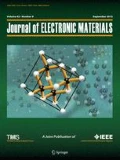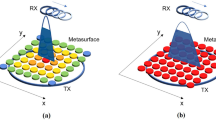Abstract
In this work, we investigate an asymmetric wireless power transfer (WPT) system constructed by a big transmitter (Tx) and a small receiver (Rx) operated at 13.56 MHz. Because of the high radius ratio between Tx and Rx coils, the efficiency of asymmetric WPT is lower than the symmetric one. Therefore, a compact metasurface placed between the Tx and Rx is used to enhance the efficiency of WPT. To further improve efficiency, we create a nonuniform metasurface by controlling the resonant frequency of the unit cells. This defect with higher resonant frequency than others is easily formed by tuning the external capacitor. This modified metasurface can strongly localize the magnetic field into the defect region at a deep subwavelength scale of 2.3λ × 10−3and is, therefore, suitable for coupling to the small Rx of asymmetric WPT. There is an optimum position of metasurface for achieving the highest efficiency when the couplings between the defect, Tx, and Rx coils are appropriate. By using the optimization approach, the efficiency of the WPT increases significantly from 9.8% to 60.2% with a nonuniform metasurface. The performances of WPT at various locations of defect and receiver are also considered.
Similar content being viewed by others
References
M. Song, P. Belov, and P. Kapitanova, Appl. Phys. Rev. 4, 021102 (2017).
W.C. Harris, D.D. Stancil, and D.S. Ricketts, Appl. Phys. Lett. 114, 143903 (2019).
N. Ha-Van, and C. Seo, IEEE Tran. Ind. Electron. 65, 1358 (2018).
I. Mayordomo, T. Drager, P. Spies, J. Bernhard, and A. Pflaum, Proc. IEEE 101, 1032 (2013).
X. Wei, Z. Wang, and H. Dai, Energies 7, 4316 (2014).
J. Park, C. Park, Y. Shin, D. Kim, B. Park, J. Cho, J. Choi, and S. Ahn, Appl. Phys. Lett. 114, 203902 (2019).
A. Markvart, M. Song, S. Glybovski, P. Belov, C. Simovski, and P. Kapitanova, IEEE Access 8, 40224 (2020).
D. Brizi, J.P. Stang, A. Monorchio, and G. Lazzi, IEEE Trans. Microw. Theory Techn. (2020). https://doi.org/10.1109/TMTT.2020.2983145.
J. Garnica, R.A. Chiga, and J. Lin, Proc. IEEE 101, 1321 (2013).
M. Xia and S. Aissa, IEEE Trans. Signal Process. 63, 2835 (2015).
A.M. Jawad, R. Nordin, S.K. Gharghan, H.M. Jawad, and M. Ismail, Energies 10, 1022 (2017).
F. Pijl, P. Bauer, and M. Castilla, IEEE Trans. Ind. Electron. 60, 382 (2013).
A. Kurs, A. Karalis, R. Moffatt, J.D. Joannopoulos, P. Fisher, and M. Soljacic, Science 317, 83 (2007).
S.Y.R. Hui, W. Zhong, and C.K. Lee, IEEE Trans. Power Electron. 29, 4500 (2014).
H.H. Lee, S.H. Kang, and C.W. Jung, IEEE Microw. Wireless Compon. Lett. 28, 269 (2018).
S. Assawaworrarit, X. Yu, and S. Fan, Nature 546, 387 (2017).
C. Yang, Y. He, H. Qu, J. Wu, Z. Hou, Z. Lin, and C. Cai, AIP Adv. 9, 025206 (2019).
T.H. Kim, G.H. Yun, and W.Y. Lee, IEEE Trans. Microw. Theory Techn. 66, 3443 (2018).
B. H. Choi, and J. H. Lee, Int. J. Antenn. Propag. 8247476 (2016).
S. Hekal, A.B. Abdel-Rahman, A. Allam, H. Jia, A. Barakat, and R.K. Pokharel, IEICE Electron. Expr 13, 21 (2016).
V.G. Veselago, Sov. Phys. Uspekhi 10, 509 (1968).
J.B. Pendry, Phys. Rev. Lett. 85, 3966 (2000).
W.J. Padilla, D.N. Basov, and D.R. Smith, Mater. Today 9, 28 (2006).
J.B. Pendry, L. Martin-Moreno, and F.J. Garcia-Vidal, Science 305, 847 (2004).
C.M. Soukoulis and M. Wegener, Nat. Photonics 5, 523 (2011).
S.A. Cummer, J. Christensen, and A. Alu, Nat. Rev. Mater. 1, 1 (2016).
A. Radkovskaya, P. Petrov, S. Kiriushechkina, A. Satskiy, M. Ivanyukovich, A. Vakulenko, V. Prudnikov, O. Kotelnikova, A. Korolev, and P. Zakharov, J. Magn. Magn. Mater. 459, 187 (2018).
C.J. Stevens, IEEE Trans. Power Electron. 30, 6182 (2015).
T.S. Pham, H.N. Bui, and J.W. Lee, J. Magn. Magn. Mater. 485, 126 (2019).
B. Wang, K.H. Teo, T. Nishino, W. Yerazunis, and J. Barnwell, Appl. Phys. Lett. 98, 254101 (2011).
A.L.A.K. Ranaweera, T.P. Duong, and J.W. Lee, J. Appl. Phys. 116, 043914 (2014).
T.S. Pham, A.K. Ranaweera, D.V. Ngo, and J.W. Lee, J. Phys. D: Appl. Phys. 50, 305102 (2017).
W. Yang, S. Ho, and W. Fu, IEEE Access 8, 82700 (2020).
A.L.A.K. Ranaweera, T.S. Pham, H.N. Bui, V. Ngo, and J.W. Lee, Sci. Rep. 9, 11735 (2019).
T.P. Duong, and J.W. Lee, IEEE Microw. Wireless Compon. Lett. 21, 442 (2011).
Author information
Authors and Affiliations
Corresponding authors
Ethics declarations
Conflict of interest
The authors declare that there are no conflicts of interest related to this article.
Additional information
Publisher's Note
Springer Nature remains neutral with regard to jurisdictional claims in published maps and institutional affiliations.
Rights and permissions
About this article
Cite this article
Pham, T.S., Khuyen, B.X., Tung, B.S. et al. Enhanced Efficiency of Asymmetric Wireless Power Transmission Using Defects in 2D Magnetic Metamaterials. J. Electron. Mater. 50, 443–449 (2021). https://doi.org/10.1007/s11664-020-08586-w
Received:
Accepted:
Published:
Issue Date:
DOI: https://doi.org/10.1007/s11664-020-08586-w




